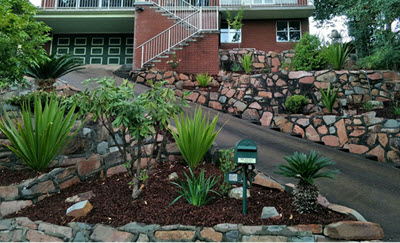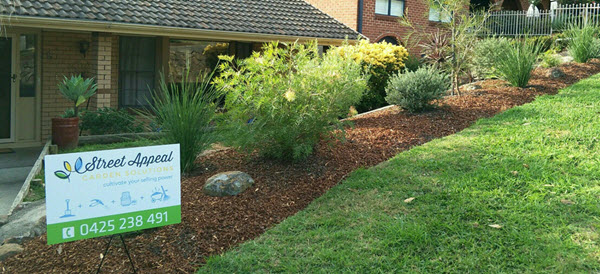 Jason Clenton loves, I mean really loves, his front yard in Narrellen Vale. He spends time trimming, pruning, mowing, rolling and sculpting every day. His lawn looks like carpet, hedges are meticulously clipped and plants are shaped to perfection. The Newcastle Herald reports that this garden obsession is a growing trend in Sydney’s South West.
Jason Clenton loves, I mean really loves, his front yard in Narrellen Vale. He spends time trimming, pruning, mowing, rolling and sculpting every day. His lawn looks like carpet, hedges are meticulously clipped and plants are shaped to perfection. The Newcastle Herald reports that this garden obsession is a growing trend in Sydney’s South West.
If you work, have kids, like clean clothes and have other responsibilities, then you are probably not likely to follow this trend!
Having well-presented and appealing gardens can be easily achieved and doesn’t have to be a daily, or even weekly chore. September is a perfect month to spend a little time setting up your gardens to cope with Summer and to look after themselves for the years to come. Implement these 6 steps and you will be well on the way to a ‘set and forget’ landscape.
1. Declutter
To create low maintenance gardens, start by digging out (not whipper snipping or poisoning!) the weeds. If you get it right the first time, you dramatically reduce the chance of them coming back. Make sure you remove all roots and bulbs. For weeds like onion weed and oxalis, you need to get rid of the surrounding soil to prevent the bulbets from picking up where the parents left off. Before you start to declutter, make sure you have organised mulch to go straight onto your garden bed. Otherwise, you’ll be doing exactly the same thing next month.
Remove all dead foliage that is still attached to your plants. This will improve air circulation and free up space for new growth. Leaf litter is actually really good for your soil, but if you don’t like the look of it in your garden beds, it’s a great addition to the compost heap.
Prune larger plants by first removing dead, diseased or spindly branches. When pruning, cut just above new shoots and constantly stand back to ensure a nice even shape.
TOP TIP: Save yourself time, effort and green waste fees by tip pruning plants while they are still young. This will give a more even and compact shape as they grow larger and reduce the amount of heavy pruning required down the track.
2. Bring in Some Good Soil
If you are planning a new garden or improving an old one, good soil can work wonders. For a new garden, mix your new soil with the old using a pitch fork or a rotary hoe. To improve the health of existing plants, spread some of the new soil around the drip line of each plant. Always go for an organic blend of composts and manures. Fresh soil will provide a steady flow of nutrients and hold in moisture. Nurseries and landscape suppliers will have great soil blends to suit your area and garden type. Improving the soil will help enormously on your journey towards ‘set and forget’!
 3. Get the Edge
3. Get the Edge
The most affordable garden edge is a spaded trench edge, but it is also high maintenance. Any material that provides a clear separation between lawn and garden is going to reduce maintenance. Timber, cement or brick edging work well and look tidy. Use existing paths and driveways to form part of the garden edging if fitting. If gardens go right up to the edge of your home, make sure you consider drainage options like ag pipe and gravel. For a more natural look, bush rock is a great choice and can easily be placed and moved.
4. Yuccas No More!
I guess Yuccas look cute when they are young, but they certainly do not grow old gracefully! Their foliage is sharp, they become overgrown very quickly and they can cause all sorts of problems for fences and retaining walls. Dracenas are similar in appearance but have softer foliage and can give a lovely tropical look.
If you have Murrayas in your gardens, then you are stuck with regular hedging. Murrayas can look great and are fast growing but they are high maintenance. Lilypillies, Metrosideros, Grevilleas and Indian Hawthorn are great screening plants and if tip pruned and fertilized during their first year, are attractive and low maintenance.
Lomandra is a strappy and tough native grass that is used often in parks and nature strips. For a home garden, the best varieties are Lomandra ‘Tanika’ and ‘Nyalla’. Liriope muscari is another lovely strappy leaved plant. If strappy turns to scrappy after a couple of years, just cut the whole lot back to the ground and enjoy the new growth.
Australian native plants can live with neglect, but a little attention to help them through their first summer, will ensure longevity and appeal for years to come.
5. Use mulch, lose the weed mat!
Mulch improves soil, suppresses weeds and holds in moisture. The best mulch for a low maintenance garden is Pine bark or Cypress mulch. It’s much cheaper to collect mulch with a trailer or have it delivered. Australian recommendations are for 5cm thickness. It’s important to keep this depth near the base of plants, but you can certainly spread thicker in the bare sections.
Our team spends a lot of time removing weed mat and the integrated weeds that have grown right through it! Weed mat works in areas where you don’t want anything at all to grow, but it is problematic in garden beds. Weed mat suffocates the soil, is very difficult to plant into, lifts at the edges, doesn’t stop all weeds and can strangle the base of your plants. Did I mention we don’t like weed mat?
TOP TIP: To really give the weeds a hard time, use a layer of sugar cane mulch before your spread Pine bark.
6. Water wisely
So, you’ve planted your new plants, are determined to water every day but your enthusiasm is challenged by the latest Netflix series! Plants in a nursery are used to being watered at least once per day, are fertilised weekly and potted up regularly. It can be a real shock for plants to go from that environment to yours.
A watering system with an automatic timer is the way to go and doesn’t have to be expensive. Start with a timer that attaches to the tap, a roll of poly tubing, pegs to secure into the ground and dripper attachments. Drip or bubbler attachments are preferable to a spray set up as they direct the water right where it is needed and less water is wasted. For new plants, I recommend watering every day for a week, then 2-3 times per week until your plants are growing and established.
Most of us want lovely outside spaces to enjoy, but not all of us have the time or inclination to be like Jason Clenton- spending every day working in the gardens. If you put in some work now by following these 6 steps, you’ll save yourself a lot of work later and be rewarded with beautiful, low maintenance landscapes.
Christine Dodd is a Horticulturist and founder of Street Appeal Garden Solutions. If you need help with creating Street Appeal for your home, contact her via the contact form on the contact us page.


Recent Comments